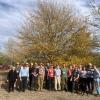Editor's Picks
Plant Focus
Presentation given at the XX International Botanical Conference, Madrid, Spain, July 21–27, 2024.
Authors:
Marta Benito Garzón1, Fany Baillou1, Filipe Costa e Silva2, Carla Faria2, Maurizio Marchi3, Giovanni Giuseppe Vendramin3, Natalia Vizcaíno-Palomar4
Affiliations:
1. BIOGECO INRAE, UMR 1202, University of Bordeaux, 33400 Pessac, France
2. Centro de Estudos Florestais, Instituto Superior de Agronomia, Universidade de Lisboa, Tapada da Ajuda, 1349-017 Lisbon, Portugal
3. Florence Research Area, CNR-Institute of Biosciences and BioResources, Via Madonna del Piano 10, 50019 Sesto Fiorentino, Firenze, Italy
4. ICIFOR, INIA-CSIC, Ctra. de La Coruña, Km 7, 5, 28040 Madrid, Spain
Abstract:
Climate change is facilitating the northward migration of Mediterranean oak species, leading to an expansion of their distribution at their leading edges. Nevertheless, Mediterranean oaks possess desiccation-sensitive acorns that lack the ability to form seed banks, relying instead on post-seed fall climate conditions and the interplay of genetic determinants for germination. In this study, we investigate Quercus suber populations' potential adaptation to rising spring temperatures in germination timing and rates.
A total of 701 acorns from 9 populations, with 10 mother trees each, were sown at temperatures of 15, 20, and 25 °C, with daily monitoring of germination over a 90-day period. Germination timing was modeled using Cox's proportional-hazards models. Populations' adaptation to the transfer distances associated with spring temperature changes and germination climatic niches under current and the RCP 8.5 scenario for the year 2080 were assessed using fixed-effects models.
Variations in germination timing were attributed to both population origin and temperature treatment, while germination rates exhibited sub-optimal tendencies under temperatures exceeding the species' native range. The timing of germination decreased in correlation with rising spring temperatures, with a projected germination occurrence in 2080 anticipated to be 12 days earlier than the present timeframe in central Iberia. Elevated spring temperatures significantly expedite the germination process of recalcitrant Mediterranean species, potentially influencing the developmental environment of seedlings and, consequently, the regeneration and species composition of populations. Consequently, germination timing deserves greater consideration in scientific and stakeholder discourse and should be integrated into forest vulnerability assessments and assisted migration programs designed to foster long-term forest adaptation to climate change.
















